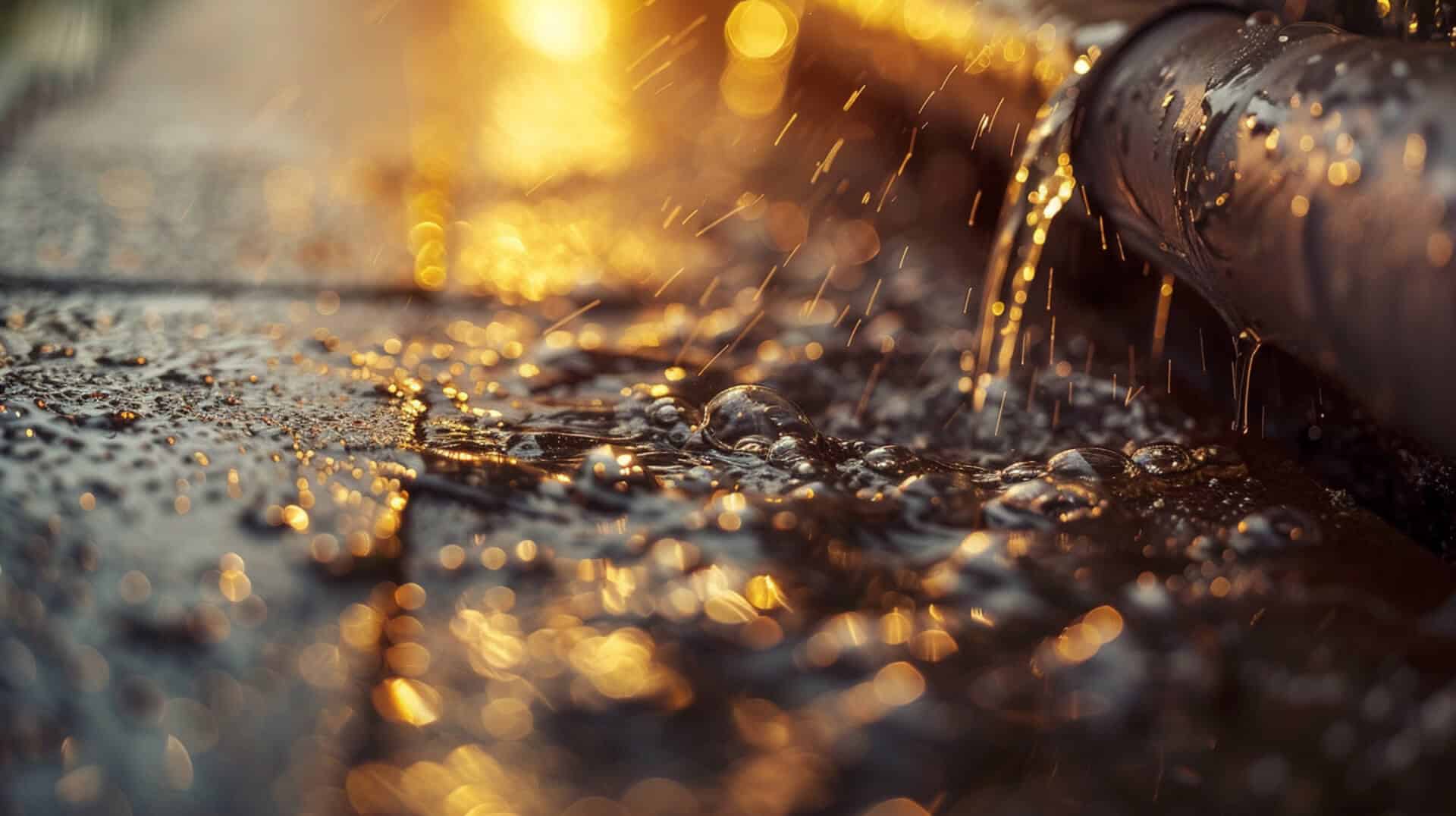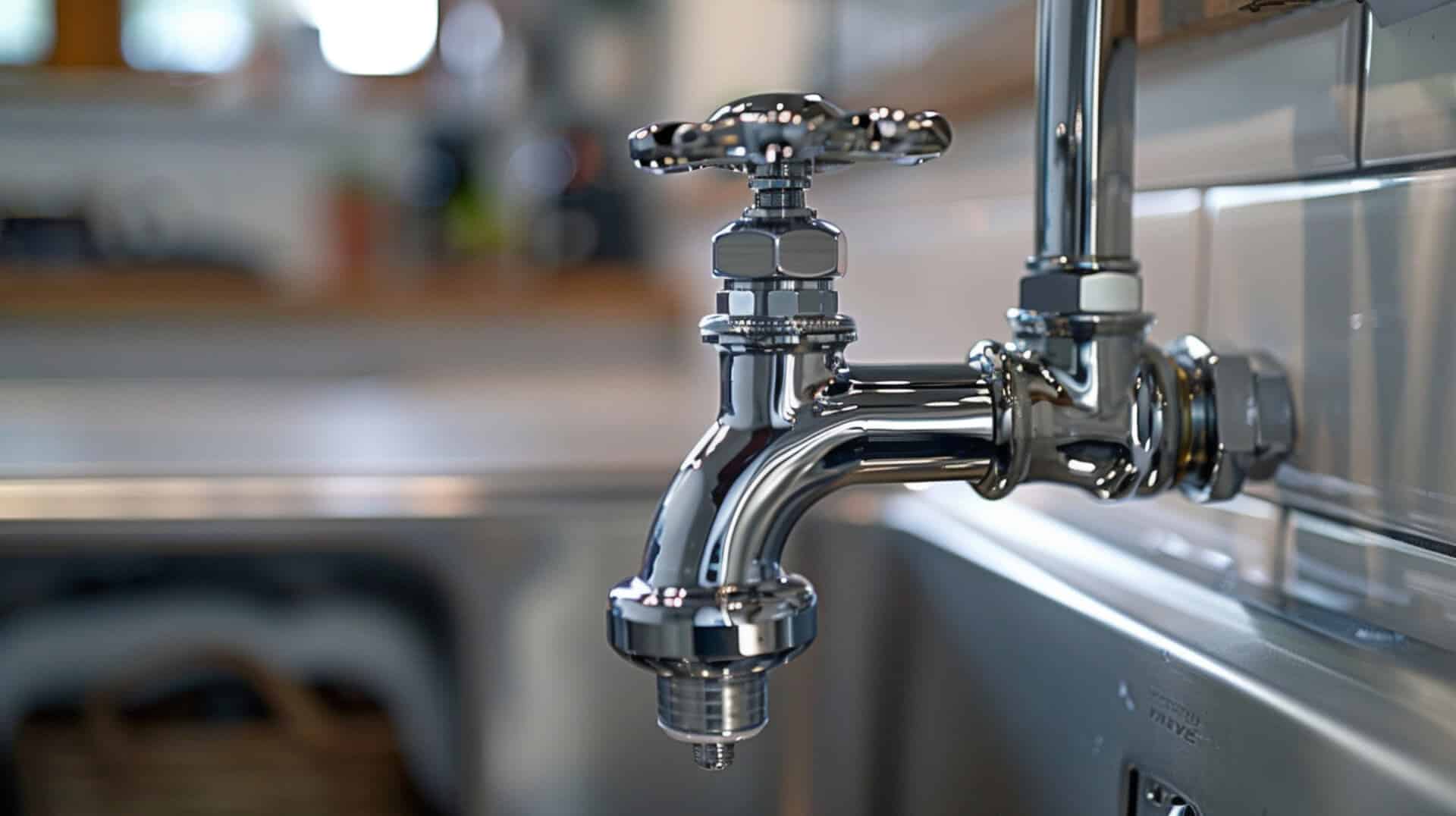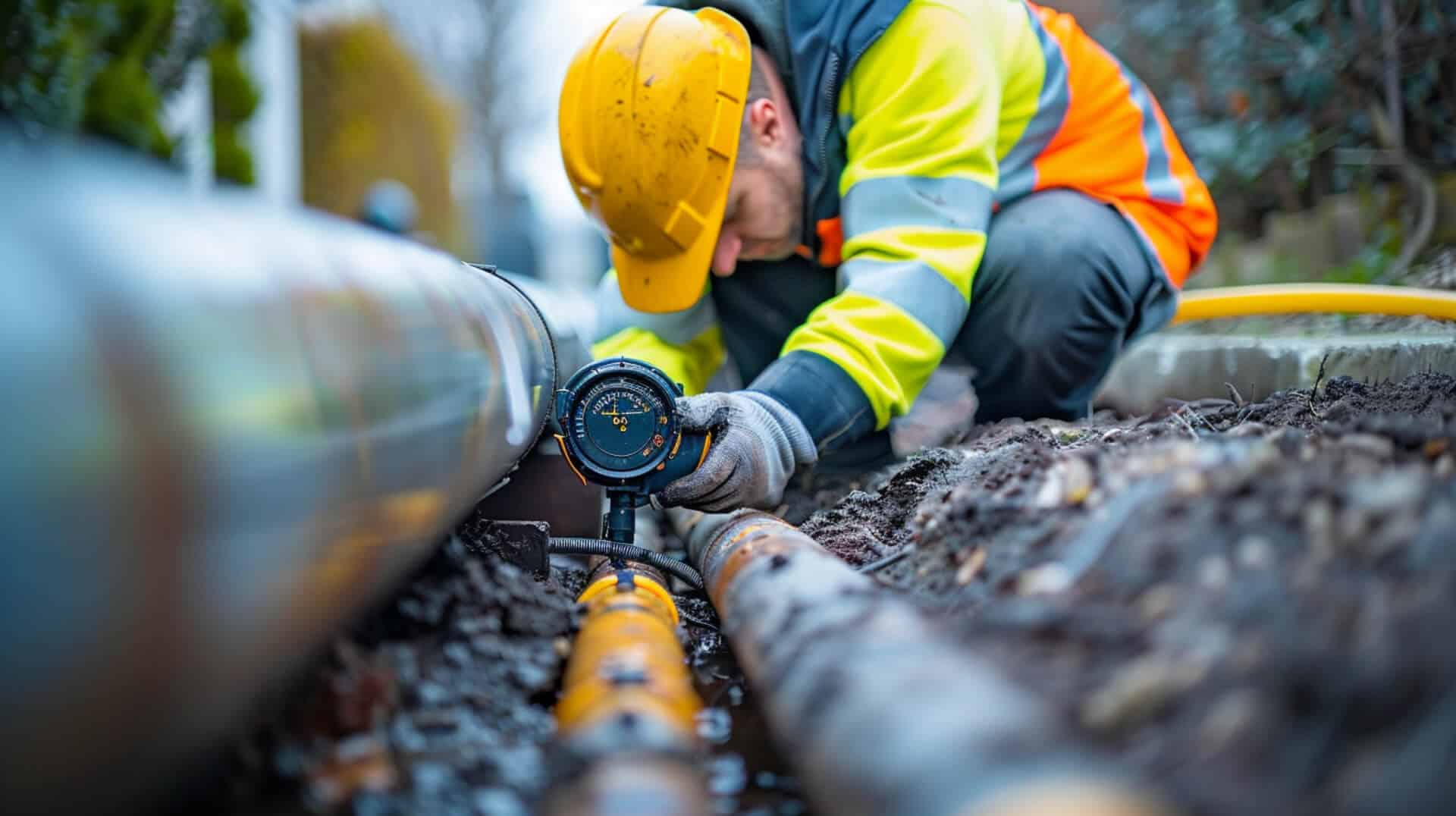 What Is The Process Of Drainage Installation Services
What Is The Process Of Drainage Installation Services
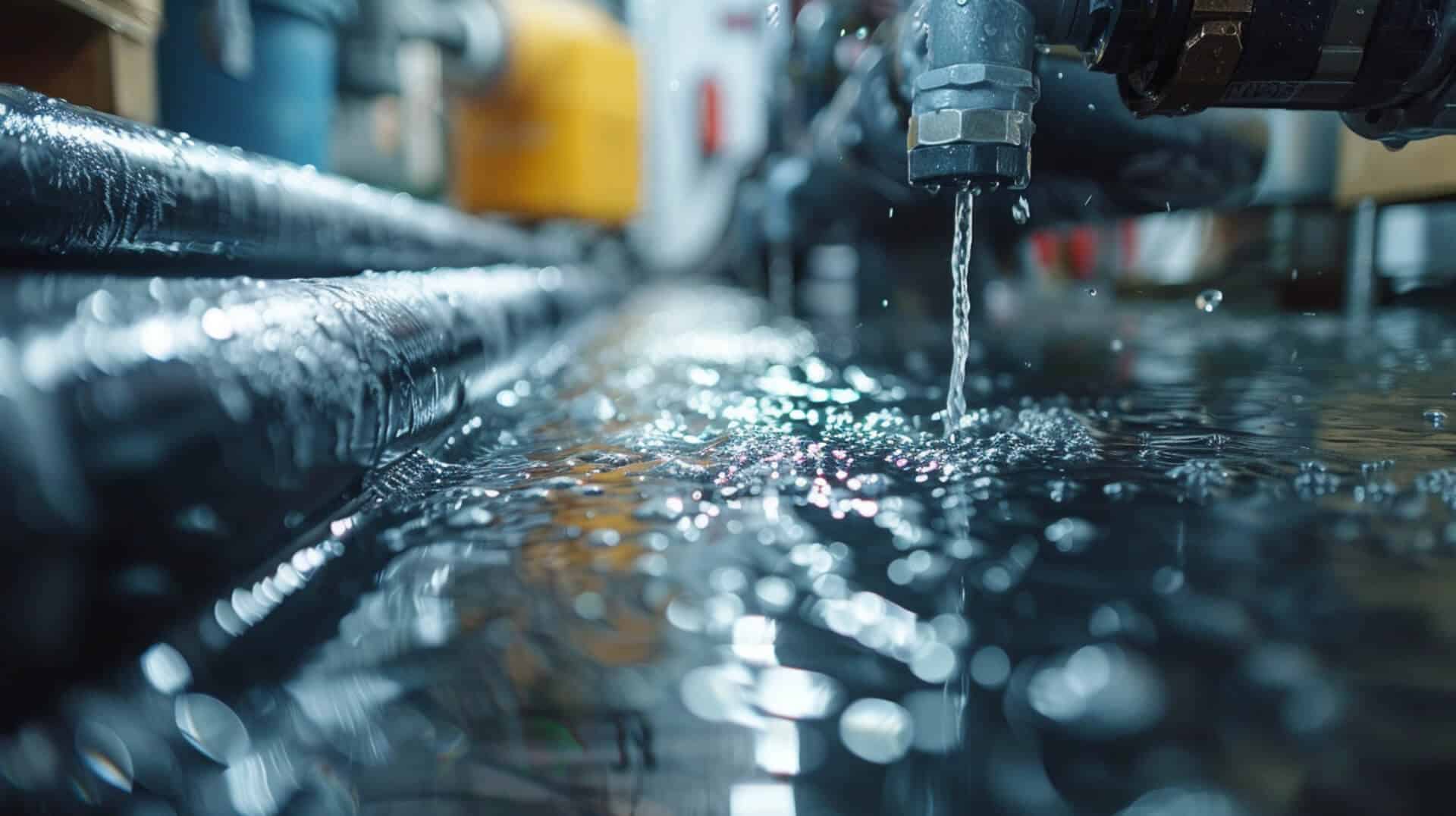
Drainage installation services encompass a comprehensive process designed to manage water flow on properties, ensuring that excess water is effectively channelled away to prevent damage and maintain the integrity of structures and landscapes. Proper drainage is crucial as it mitigates risks associated with water pooling, soil erosion, and potential foundation damage.
What Constitutes a Drainage Installation Service?
A drainage installation service typically includes an initial consultation, site assessment, design of the drainage plan, selection of appropriate materials, excavation, pipe installation, and final testing to ensure functionality. These services are tailored to address the unique water management needs of each property.
Why Is Proper Drainage Essential for Properties?
Effective drainage systems protect properties from water-related issues by directing excess water away from structures to appropriate outlets. This is vital to prevent water accumulation that can lead to costly damages such as weakened foundations, flooded basements, and landscape degradation.
How Does the Drainage Installation Process Begin?
The process begins with a thorough assessment of the property’s topography, soil type, and existing water flow patterns. This initial evaluation informs the design of a drainage system that aligns with the specific requirements and challenges of the site.
What Are the Key Components of a Drainage System?
Key components include pipes, fittings, drains, and potentially pumps, all of which work together to facilitate the smooth transit of water away from the property. The system’s design is dependent on various factors such as property size, the volume of water to be managed, and environmental considerations.
Understanding Different Types of Drainage Systems
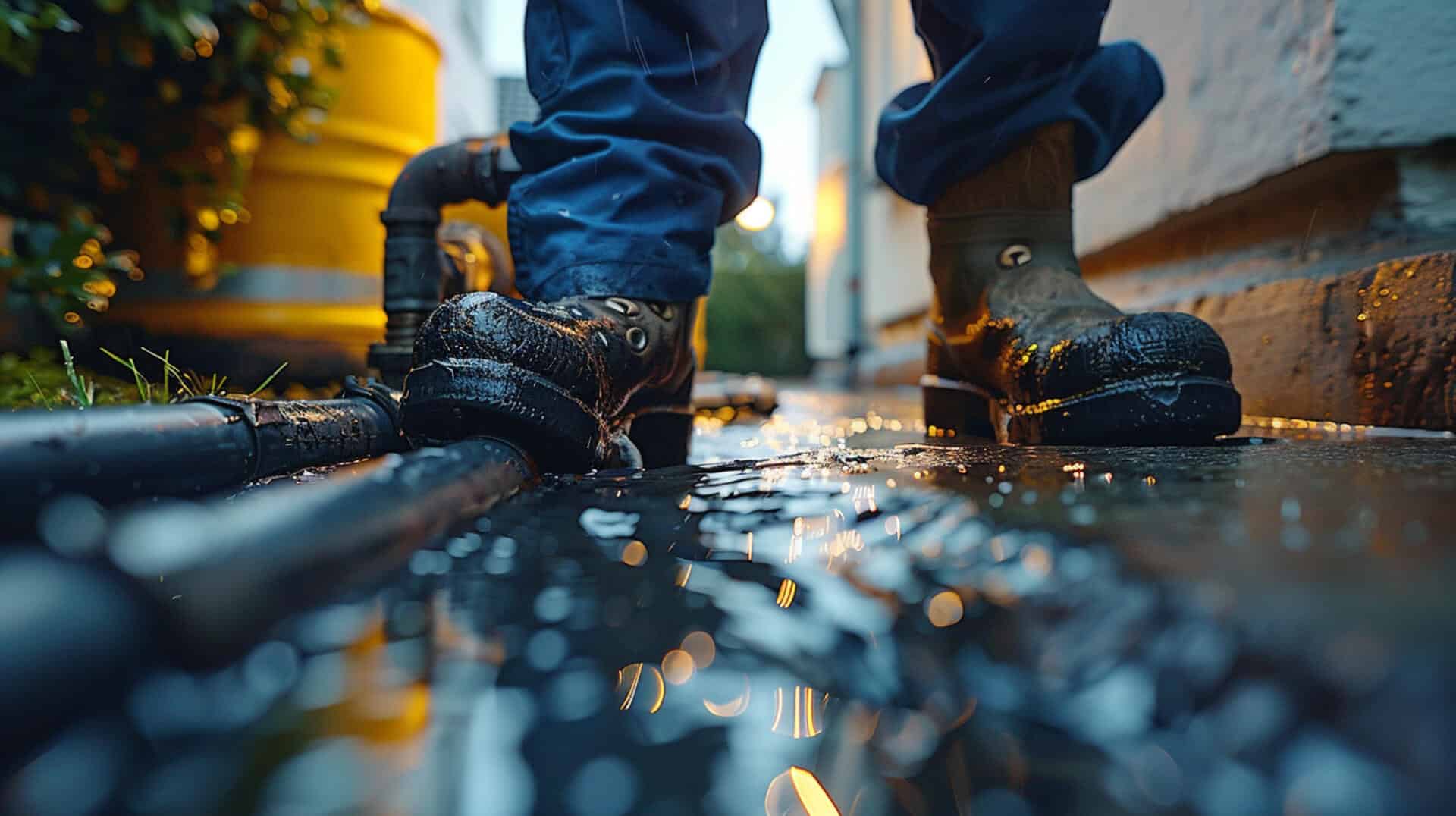
When considering the installation of a drainage system, it is essential to understand the various types available and their respective functions. Drainage systems are primarily categorised into surface and subsurface systems, each designed to manage water flow efficiently and prevent potential water damage to properties.
Surface Drainage Systems
Surface drainage systems are engineered to remove excess water from the ground’s surface. Typically, these systems are suitable for areas prone to rainwater pooling and are designed to channel water away from buildings, reducing the risk of flooding and soil erosion.
Subsurface Drainage Systems
In contrast, subsurface drainage systems, also known as underground drainage systems, are utilised to manage water at a deeper level. These systems are crucial for properties where high water tables can cause structural issues or where soil permeability is low. Subsurface systems collect and redirect water away from the foundation, preserving the structural integrity of the property.
Selection Criteria for Drainage Systems
The choice of a drainage system is influenced by several factors, including the type of property, local environmental conditions, and the specific water management needs. For instance, residential properties may require simpler solutions compared to commercial facilities that handle larger volumes of water.
Environmental Considerations
Environmental factors also play a significant role in selecting a drainage system. The impact on local ecosystems, the potential for sustainable water management, and the use of eco-friendly materials are considerations that guide the decision-making process.
By assessing these key aspects, you can determine the most appropriate drainage system for your property, ensuring effective water management and long-term protection against water-related damage.
Initial Planning and Site Assessment
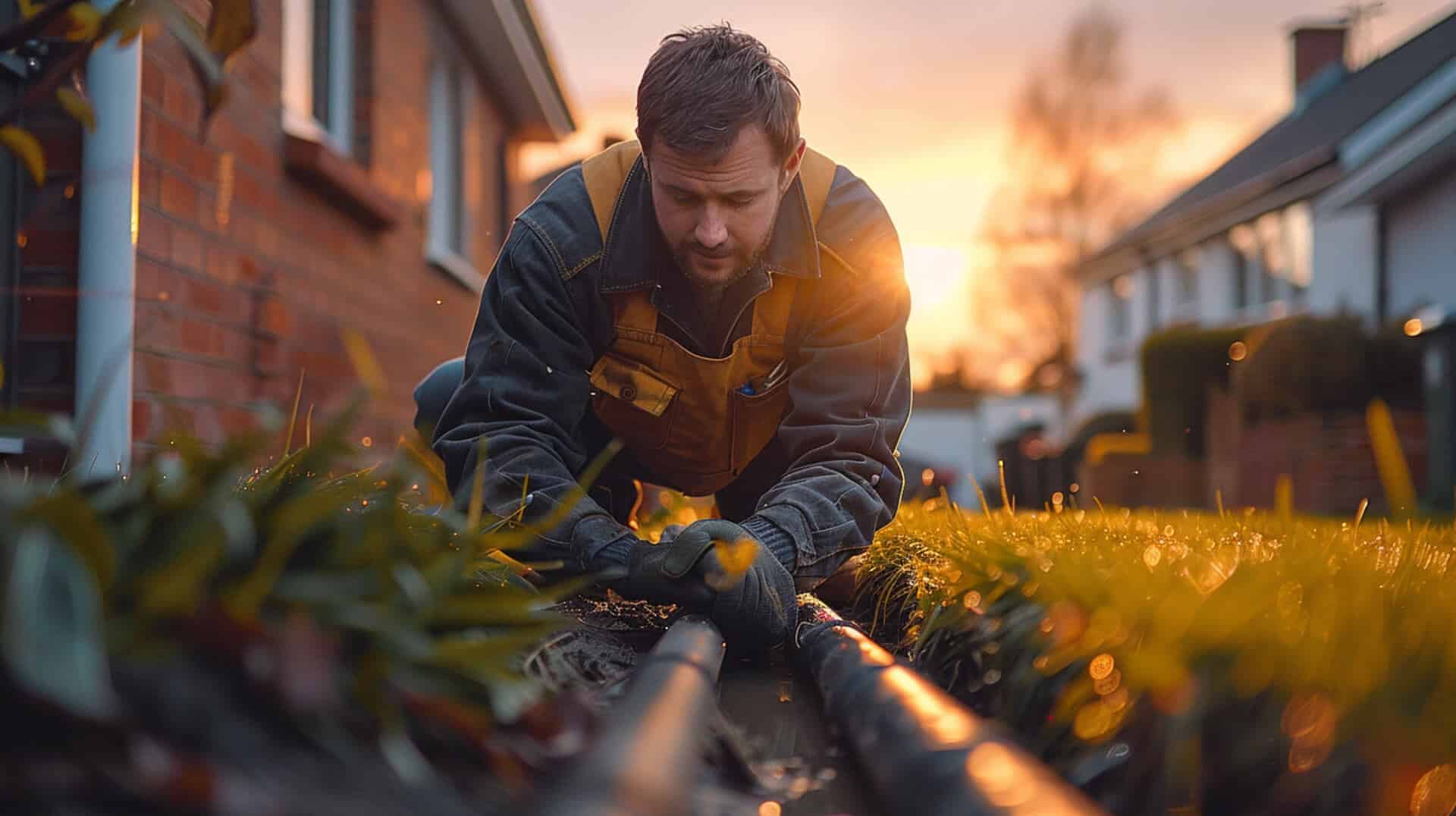
The initial planning and site assessment are critical first steps in the drainage installation process. This phase lays the groundwork for a successful installation, tailored to the specific needs of your property.
Steps in the Initial Planning Phase
The planning phase begins with a comprehensive evaluation of your property’s current drainage situation. This includes identifying existing water flow patterns, potential problem areas, and the overall objectives of the new drainage system. Professionals will also review any previous drainage plans or installations to ensure compatibility and effectiveness.
Site Assessment for Drainage Needs
A thorough site assessment follows, where professionals analyse the property’s topography, soil type, and water table levels. This assessment determines the most effective drainage system design, taking into account the natural movement of water through the property and the capacity required to handle expected water volumes.
Role of Property Size and Topography
Property size and topography significantly influence the drainage system’s design. Larger properties or those with complex landscapes may require more extensive drainage solutions. The topography, including slopes and elevation changes, dictates how water naturally flows and accumulates, informing the placement and depth of drainage components.
Impact of Local Regulations
Local regulations play a pivotal role in the installation process. These regulations may dictate the types of materials used, installation methods, and maintenance requirements. Compliance with local building codes and environmental guidelines ensures the drainage system is legally sound and environmentally responsible.
By carefully considering these factors, the initial planning and site assessment ensure that the drainage system is designed and installed to meet the unique needs of your property while adhering to all regulatory requirements.
Selection of Materials for Drainage Systems
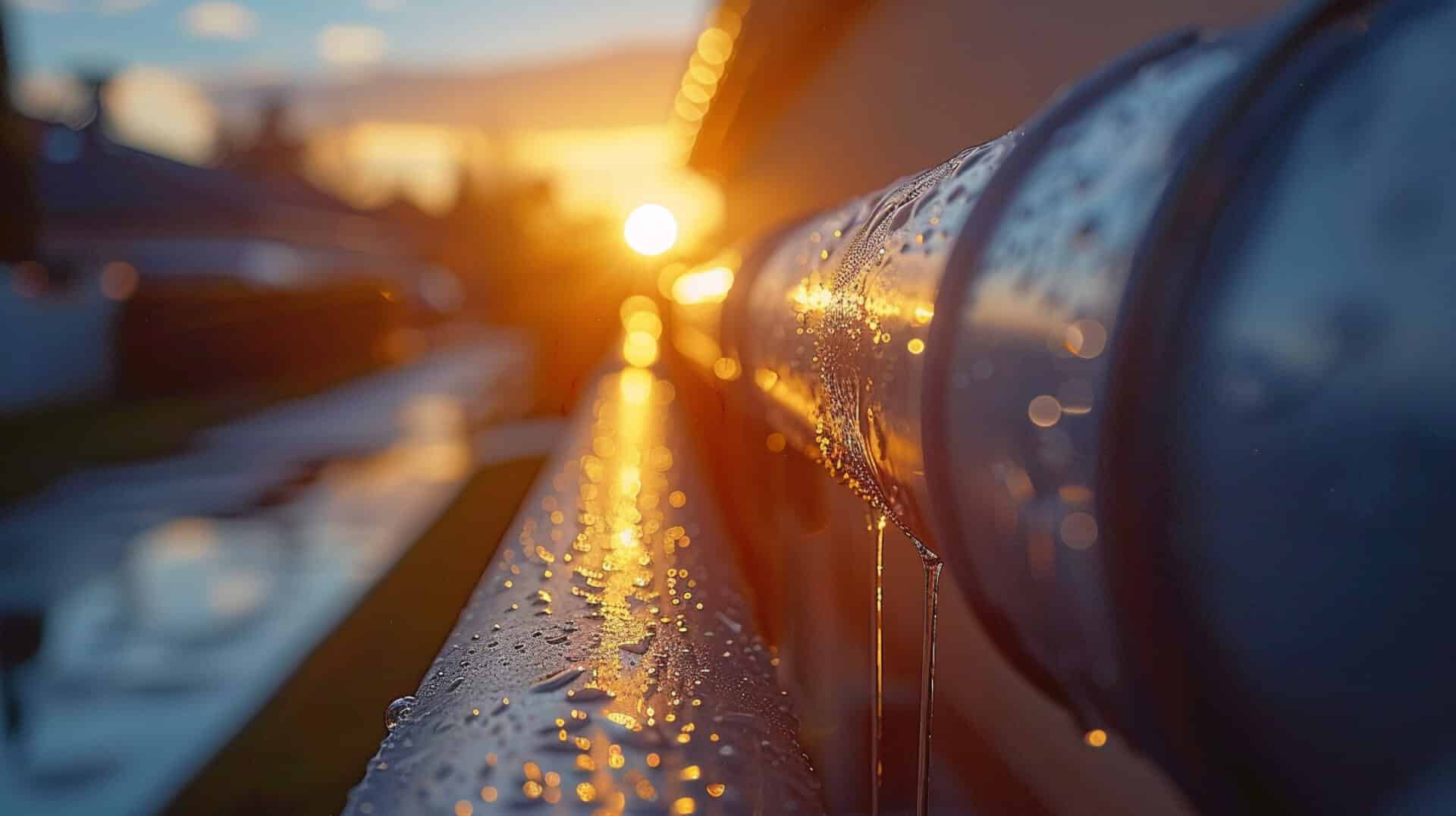
The selection of materials for drainage systems is a crucial decision that affects the performance, durability, and environmental impact of the installation. Various materials are available, each with specific properties that make them suitable for different applications.
Commonly Used Materials
Drainage systems utilise a range of materials, including:
- Vitrified Clay: Known for its longevity and resistance to chemical corrosion.
- uPVC: Favoured for its lightweight nature and ease of installation.
- Concrete: Offers strength and durability, suitable for heavy loads.
- Iron: Typically used for its robustness in public sewer systems.
- GRP (Glass Reinforced Plastic): Provides flexibility and resistance to corrosive substances.
- HDPE (High-Density Polyethylene): Recognised for its flexibility and resistance to impact.
- Pitch Fibre: Once popular, now less common due to its susceptibility to deformation.
Impact of Material Properties
The performance of a drainage system is directly influenced by the properties of the materials used. For example, the rigidity of concrete can withstand heavy loads, while the flexibility of HDPE can be advantageous in areas with ground movement.
Environmental Considerations
The environmental impact of materials is an important consideration. Vitrified clay, for instance, has a lower energy footprint during production compared to plastics, making it a more sustainable choice.
Influence on Installation and Maintenance Costs
Material choice also affects installation and maintenance costs. uPVC’s lightweight and ease of handling can reduce labour costs, while the durability of materials like vitrified clay can minimise long-term maintenance expenses.
By carefully evaluating these factors, you can select the most appropriate materials for your drainage system, balancing performance requirements with environmental impact and cost considerations.
Designing the Drainage System
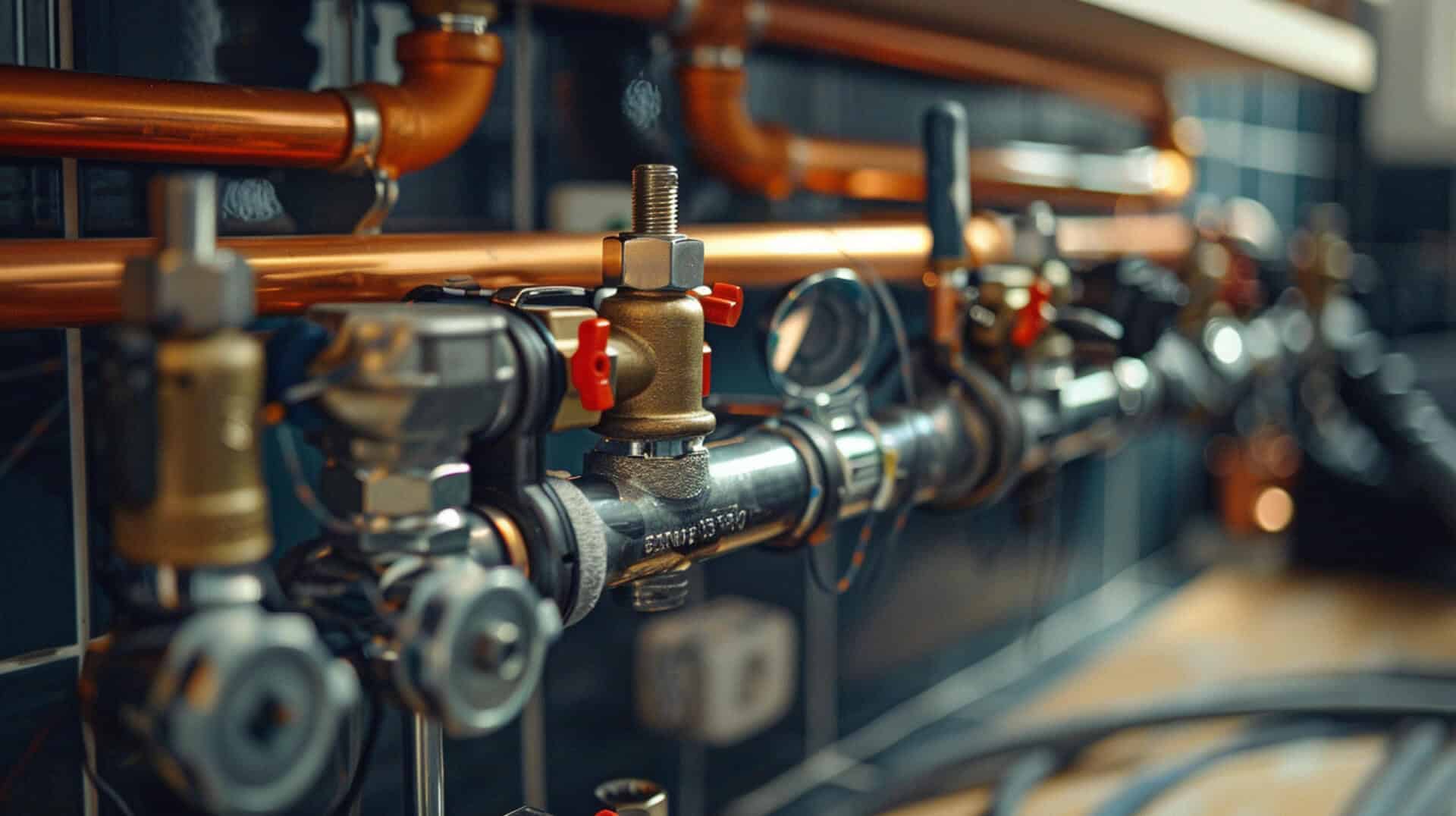
Designing an effective drainage system is a meticulous process that requires careful consideration of a property’s unique characteristics and water management needs.
Tailoring to Property Needs
The design process begins with an assessment of the property’s layout, including the identification of critical areas that require drainage. Factors such as the property’s size, existing structures, and the natural landscape are taken into account to ensure that the system addresses specific water flow challenges.
Water Flow and System Capacity
To manage water flow efficiently, the system’s capacity is calculated based on anticipated water volume, which may stem from rainfall, groundwater, or nearby water bodies. The design must accommodate peak flow conditions to prevent overflow and potential water damage.
Calculating Gradients and Invert Levels
Gradients and invert levels are critical for ensuring proper water flow through the drainage system. A gradient of 1:100 is standard for surface water, while a steeper gradient of 1:40 is used for foul water, with adjustments made if a toilet is connected (1:80). These calculations are vital for minimising blockages and ensuring a self-cleansing velocity.
Utilisation of Design Software
Professionals often employ specialised software and tools to create precise drainage plans. These tools facilitate the accurate calculation of gradients, pipe sizes, and the positioning of fittings and access points, ensuring the system’s efficiency and compliance with regulatory standards.
By integrating these considerations, the design of the drainage system is optimised to meet the demands of the property, providing a robust solution for water management.
Excavation and Trenching Techniques
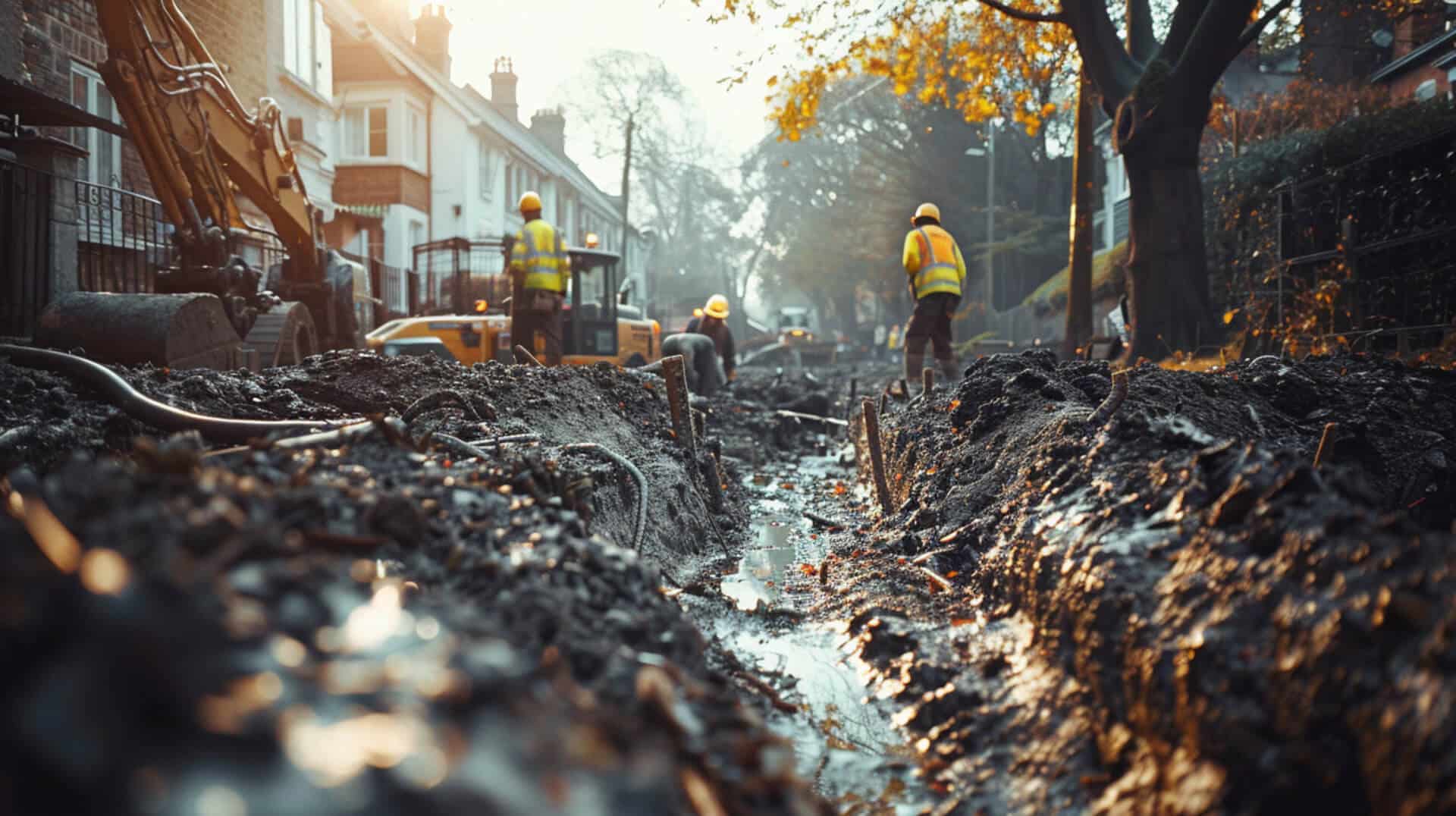
Excavation and trenching are foundational steps in the drainage installation process, requiring precision and adherence to safety standards to ensure the longevity and effectiveness of the drainage system.
Best Practices for Excavation and Trenching
When excavating for drainage, it is crucial to follow best practices:
- Precision in Gradient: Maintaining the correct gradient is essential for water flow. A gradient of 1:100 is standard for surface water, while foul water systems typically require a 1:40 gradient, adjusted to 1:80 if a toilet is connected.
- Alignment: The use of string lines or laser equipment ensures that pipes are laid straight and at the correct levels.
- Protection: Trenches should be lined with pea shingle or similar material to protect the pipes from damage.
Ensuring Safety During Excavation
Safety during the excavation process is paramount:
- Trench Shoring: For trenches deeper than 1.2 metres, shoring is necessary to prevent collapse.
- Warning Tapes: These are placed above the pipes before backfilling to warn of the drainage system’s presence during future excavations.
Soil Erosion Prevention Techniques
To prevent soil erosion during excavation:
- Stabilisation: The sides of trenches are stabilised to prevent soil from collapsing into the trench.
- Water Management: Proper water management techniques are employed to prevent erosion caused by water flow.
Adaptation to Different Soil Types
Excavation methods must be adapted to the soil type:
- Soil Assessment: Prior to excavation, the soil type is assessed to determine the most appropriate excavation technique.
- Equipment Selection: Different soil types may require specific types of excavation equipment to ensure the integrity of the trench and safety of the workers.
By adhering to these practices, you can ensure that the excavation and trenching phase of drainage installation is conducted safely, efficiently, and with minimal environmental impact.
Installation of Pipes and Fittings
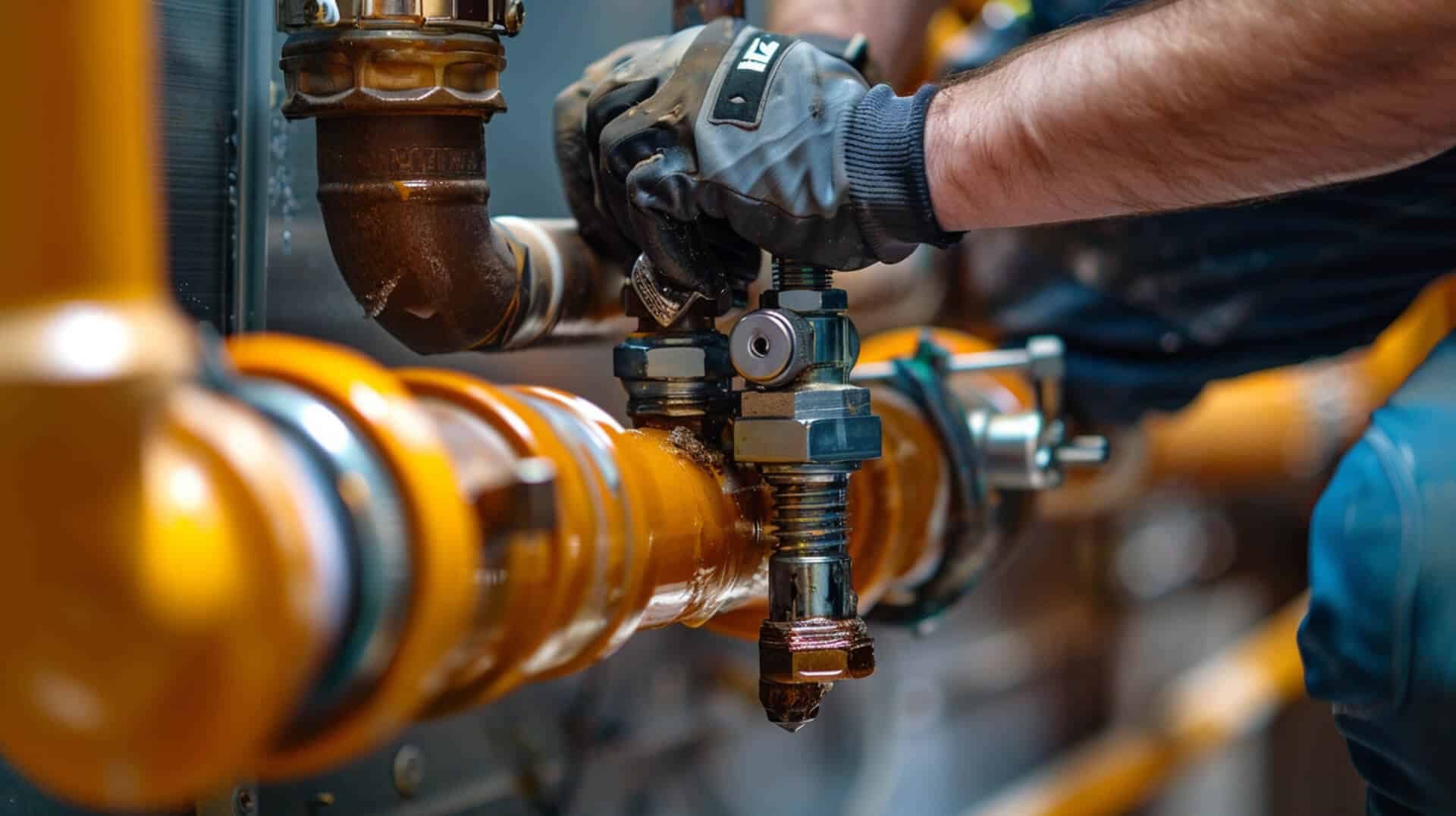
The correct installation of pipes and fittings is a pivotal component of the drainage installation process, ensuring the system’s functionality and longevity.
Correct Installation Practices
To instal pipes and fittings properly:
- Alignment and Gradient: Pipes must be laid with precision, adhering to the predetermined gradient for optimal water flow. A standard gradient of 1:100 for surface water and 1:40 for foul water is maintained, with adjustments for connected toilets.
- Joint Types: The selection of joint types, such as ring-seal for flexibility and solvent weld for pressure resistance, is based on the specific requirements of the system.
- Cutting Tools: Material-specific tools are used for cutting pipes, ensuring clean cuts and proper fit. For example, a hacksaw is suitable for plastic pipes, while a pipe-cutter is preferred for clay.
Ensuring Longevity and Integrity
To ensure the longevity and integrity of the installed pipes:
- Bedding: Appropriate bedding supports the pipes, with Class D bedding for clay and granular bedding for plastic, tailored to the load and soil type.
- Cover: A minimum of 300mm cover is provided to protect the pipes, with concrete encasement for added protection in certain locations.
Connections to Existing Systems
Connections to existing drainage or sewer systems are made using:
- Adapters: These ensure seamless integration with above-ground systems, maintaining the integrity of the connection.
- Rubber Connectors: For mixed-material connections, rubber connectors provide a flexible and secure solution.
Challenges in Varied Terrains
The installation process may face challenges in varied terrains, such as:
- Uneven Ground: Specialised techniques are employed to maintain the correct gradient and alignment.
- Hard Soil: Additional equipment may be required to excavate and prepare the site.
By adhering to these practices, you can be assured that the pipes and fittings are installed correctly, providing a robust and efficient drainage system.
Bedding and Backfilling for Pipe Protection
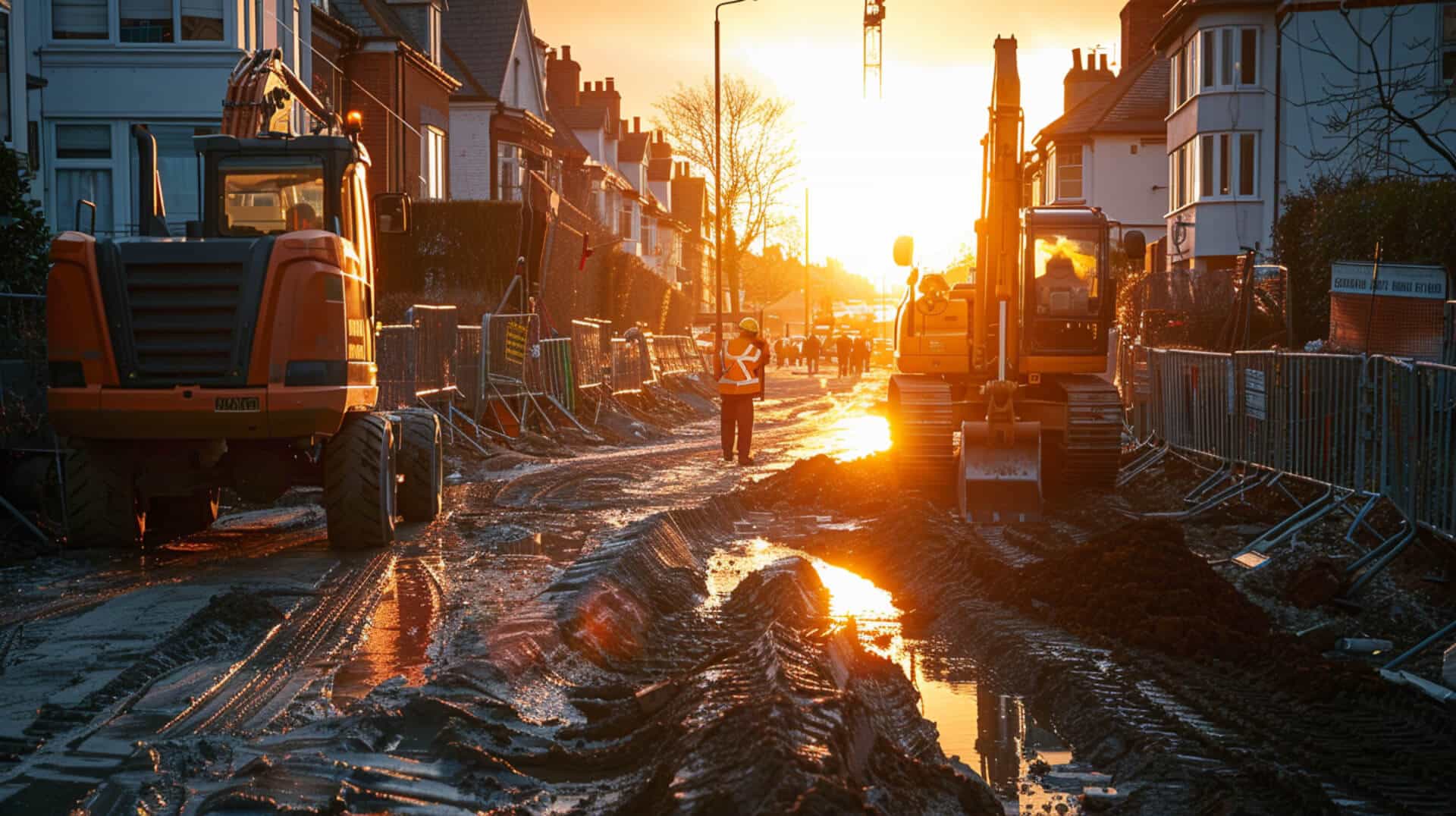
The installation of a drainage system involves critical steps beyond just laying pipes. Bedding and backfilling are essential practices that protect the integrity of the pipes and ensure the longevity of the system.
Materials Used for Bedding and Backfilling
For bedding and backfilling, materials are chosen based on their ability to support and protect the drainage pipes:
- Class D Bedding: Utilised for clay pipes, providing a stable base that can withstand the weight and pressure of the soil above.
- Granular Bedding: Often used for plastic pipes, it allows for proper drainage around the pipe and helps prevent pipe deformation.
- Pea Shingle: Commonly employed in trench beds to cushion the pipes and facilitate drainage.
Supporting the Drainage System with Proper Bedding
Proper bedding is crucial for the drainage system as it:
- Ensures that pipes have a stable base.
- Prevents pipes from shifting or breaking under pressure.
- Aids in the distribution of weight and mechanical loads.
Techniques for Effective Backfilling
Effective backfilling involves:
- Layering the backfill material to avoid voids and ensure compaction.
- Using machinery or hand tools to compact the backfill material gently around the pipes.
- Ensuring that the backfill material does not damage the pipes during the process.
Testing System Integrity After Backfilling
Once backfilling is complete, the system is tested for integrity by:
- Conducting water tests to check for leaks.
- Using CCTV inspections to ensure there are no obstructions or misalignments.
- Verifying that the gradients and flow rates meet the design specifications.
By meticulously executing these steps, you can be confident that the drainage system will function as intended, providing reliable water management for your property.
Environmental Considerations and Sustainability Practices
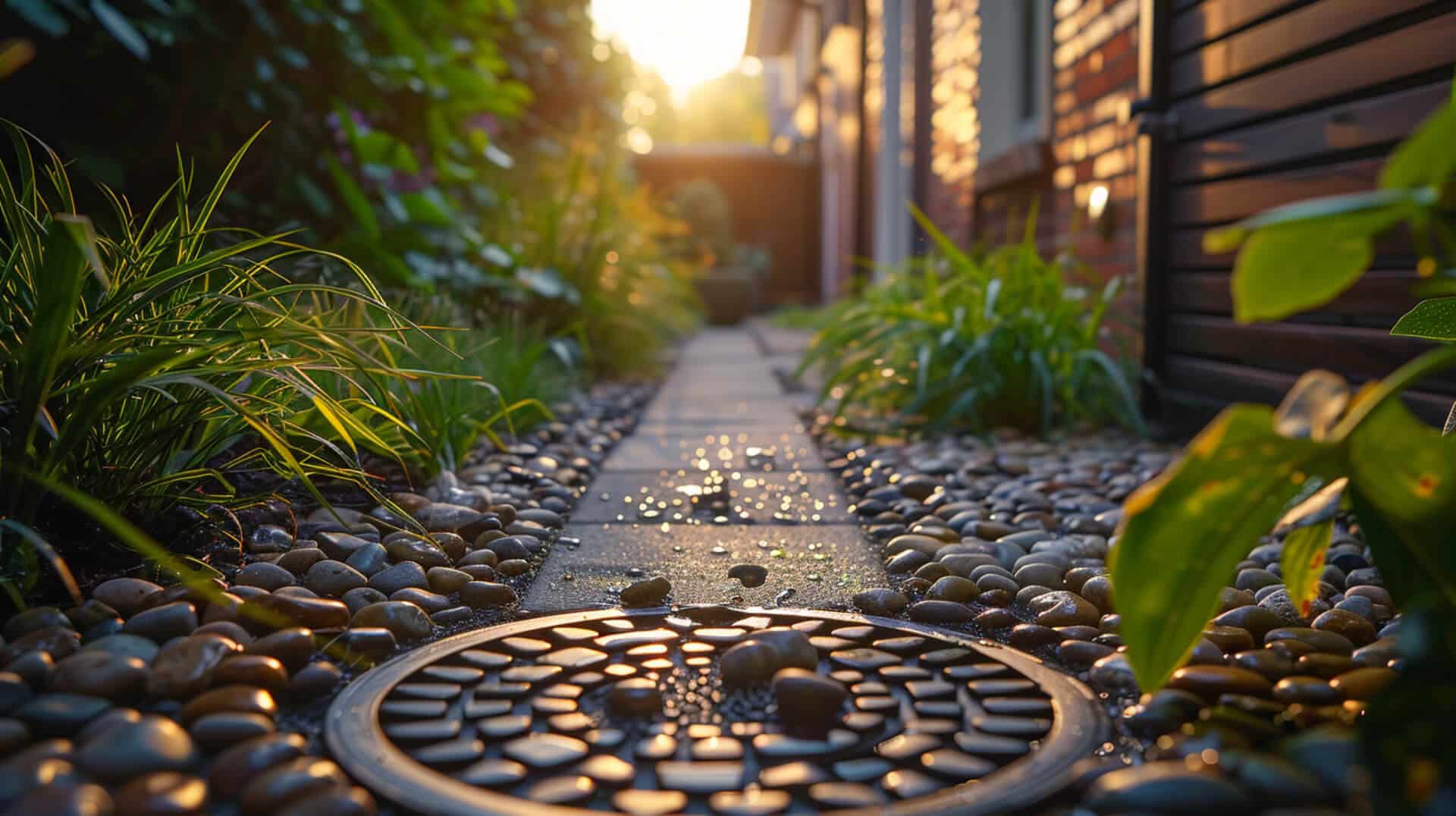
Incorporating sustainability into drainage installations is becoming increasingly important. As you explore options for your property’s drainage system, understanding the environmental impacts and the role of eco-friendly practices is essential.
Assessing the Environmental Impact of Drainage Materials
Different materials used in drainage systems have varying environmental footprints:
- Vitrified Clay: Offers a lower energy production process and longevity, reducing the need for replacements.
- Plastic Pipes: While convenient for installation, consider the environmental cost of production and the potential for recycling at the end of their life cycle.
Designing Eco-Friendly Drainage Solutions
Eco-friendly drainage solutions are designed with sustainability in mind:
- Material Selection: Choosing materials with a lower environmental impact, such as recycled or sustainably sourced options.
- System Design: Creating systems that minimise disruption to natural water cycles and promote groundwater recharge.
The Role of Sustainable Urban Drainage Systems (SuDS)
SuDS play a crucial role in sustainable drainage:
- Water Management: They manage rainfall in a way that mimics natural processes, reducing flood risk and improving water quality.
- Biodiversity: SuDS can enhance local biodiversity and provide valuable habitats for wildlife.
By considering these environmental factors, you can make informed decisions that contribute to a more sustainable approach to drainage, benefiting both your property and the wider ecosystem.
Maintenance and Troubleshooting of Drainage Systems
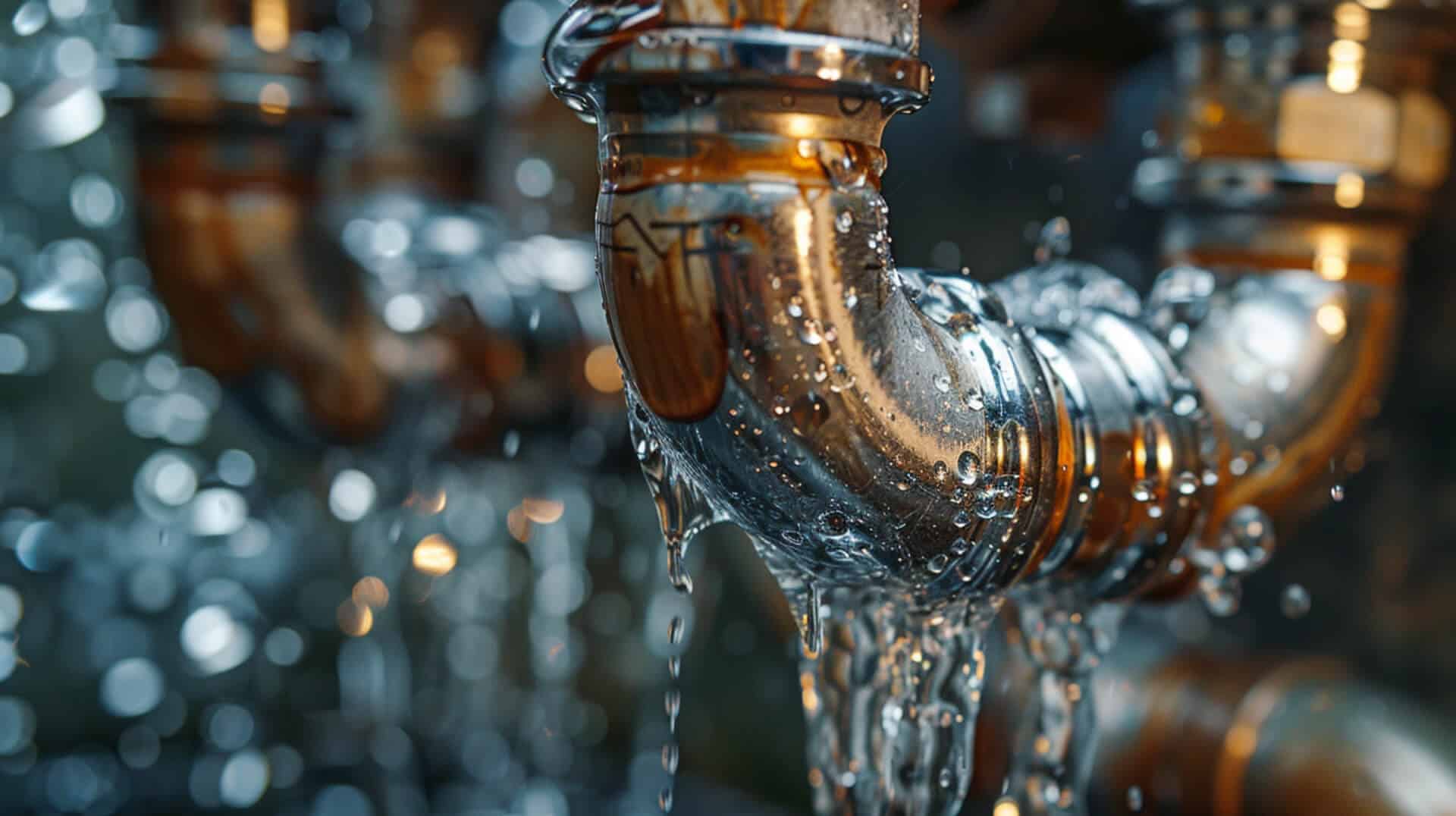
Maintaining a drainage system is essential to ensure its longevity and functionality. Regular checks and proactive measures can prevent common issues that may lead to more significant problems.
Routine Maintenance for Drainage Systems
Routine maintenance tasks include:
- Inspections: Conducting annual inspections to identify potential issues early.
- Clearing Debris: Regularly clearing gutters, hoppers, and gullies to prevent blockages.
- Hydro Jetting: Employing professional hydro jetting services to clear stubborn obstructions in the pipes.
Diagnosing and Resolving Drainage Problems
To diagnose and resolve drainage issues:
- CCTV Surveys: Utilising CCTV surveys to visually inspect the interior of drainage pipes.
- Professional Assessment: Engaging professionals to assess and address issues such as blockages, leaks, or odours.
Signs of Drainage System Repair or Replacement
Indicators that a drainage system may need repair or replacement include:
- Persistent Blockages: Recurring blockages even after clearing efforts.
- Structural Damage: Visible cracks or misalignment in pipes.
- Water Pooling: Accumulation of water in areas that should be drained.
Preventing Future Drainage Issues
Property owners can prevent future drainage issues by:
- FOG Management: Avoiding the disposal of fats, oils, and grease (FOG) down the drains.
- Regular Maintenance: Adhering to a consistent maintenance schedule.
- Professional Consultation: Seeking professional advice for any concerns or before undertaking significant landscaping that may affect the drainage system.
By following these guidelines, you can maintain an efficient drainage system and mitigate the need for costly repairs or replacements.
Navigating Legal Requirements and Building Regulations
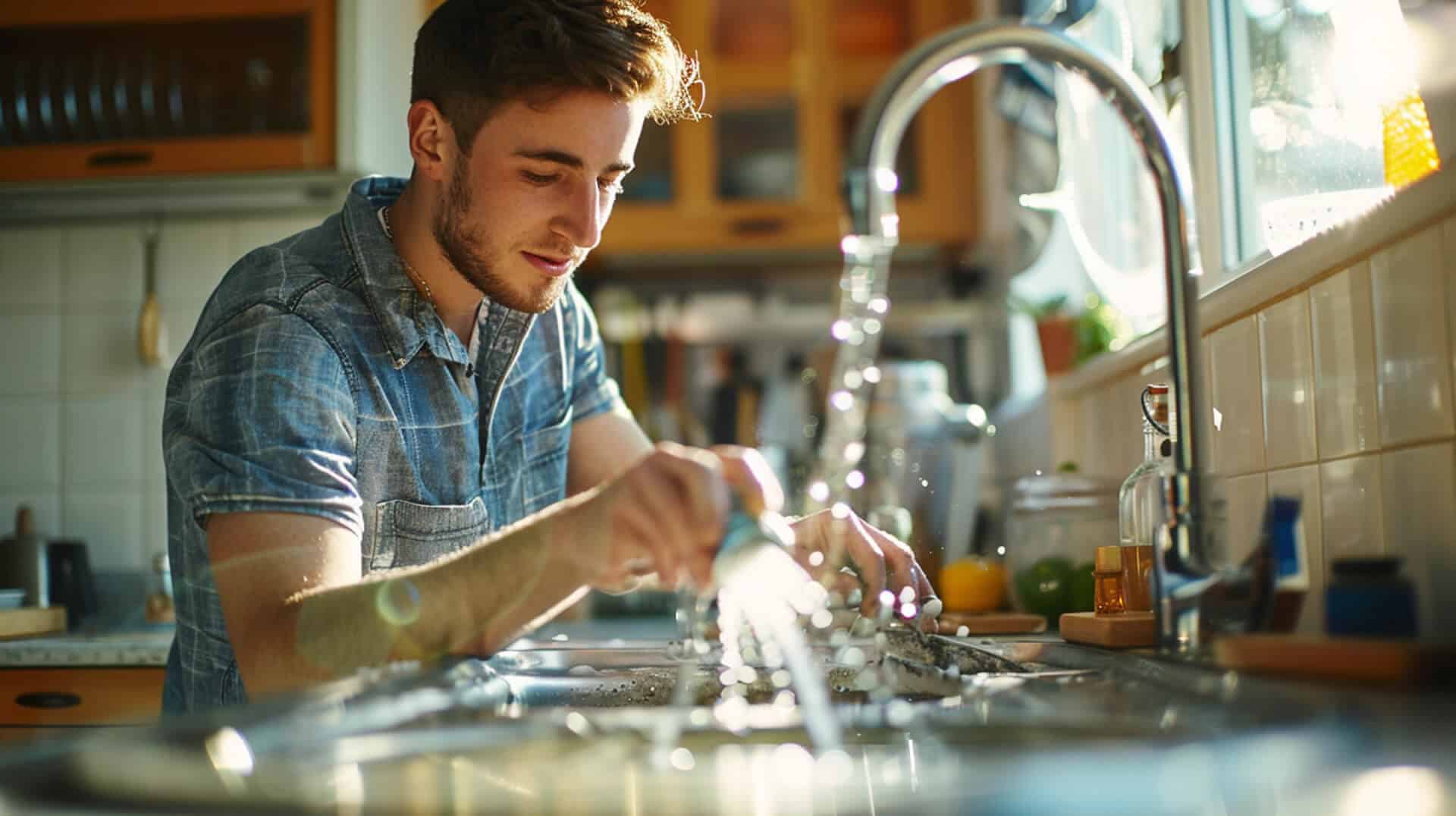
Compliance with legal standards is a critical aspect of the drainage installation process. Understanding and adhering to these requirements ensures that your drainage system is not only effective but also lawful.
Legal Considerations in Drainage Installation
When planning a drainage installation, it is important to consider:
- Local Authority Guidelines: These may dictate the permissible materials, installation methods, and design specifications for drainage systems.
- Environmental Regulations: Certain materials or practices may be regulated to protect the local ecosystem.
Impact of Building Codes and Regulations
Building codes and regulations have a direct impact on drainage installations by:
- Setting Standards: They establish minimum standards for design, materials, and workmanship.
- Ensuring Safety: Compliance with these codes ensures that the installation poses no risk to public health or safety.
Required Permits for Drainage Projects
Most drainage installation projects will require permits, which:
- Authorise the Work: They serve as official permission to begin the installation.
- Ensure Oversight: Inspections may be required as part of the permitting process to ensure the work meets all standards.
Ensuring Compliance with Standards
Property owners can ensure compliance by:
- Consulting Professionals: Engaging with experienced professionals who are familiar with local regulations.
- Staying Informed: Keeping abreast of any changes in legislation that may affect drainage installations.
By taking these steps, you can navigate the legal landscape effectively, ensuring that your drainage installation meets all necessary regulations and standards.
Key Takeaways in Drainage Installation
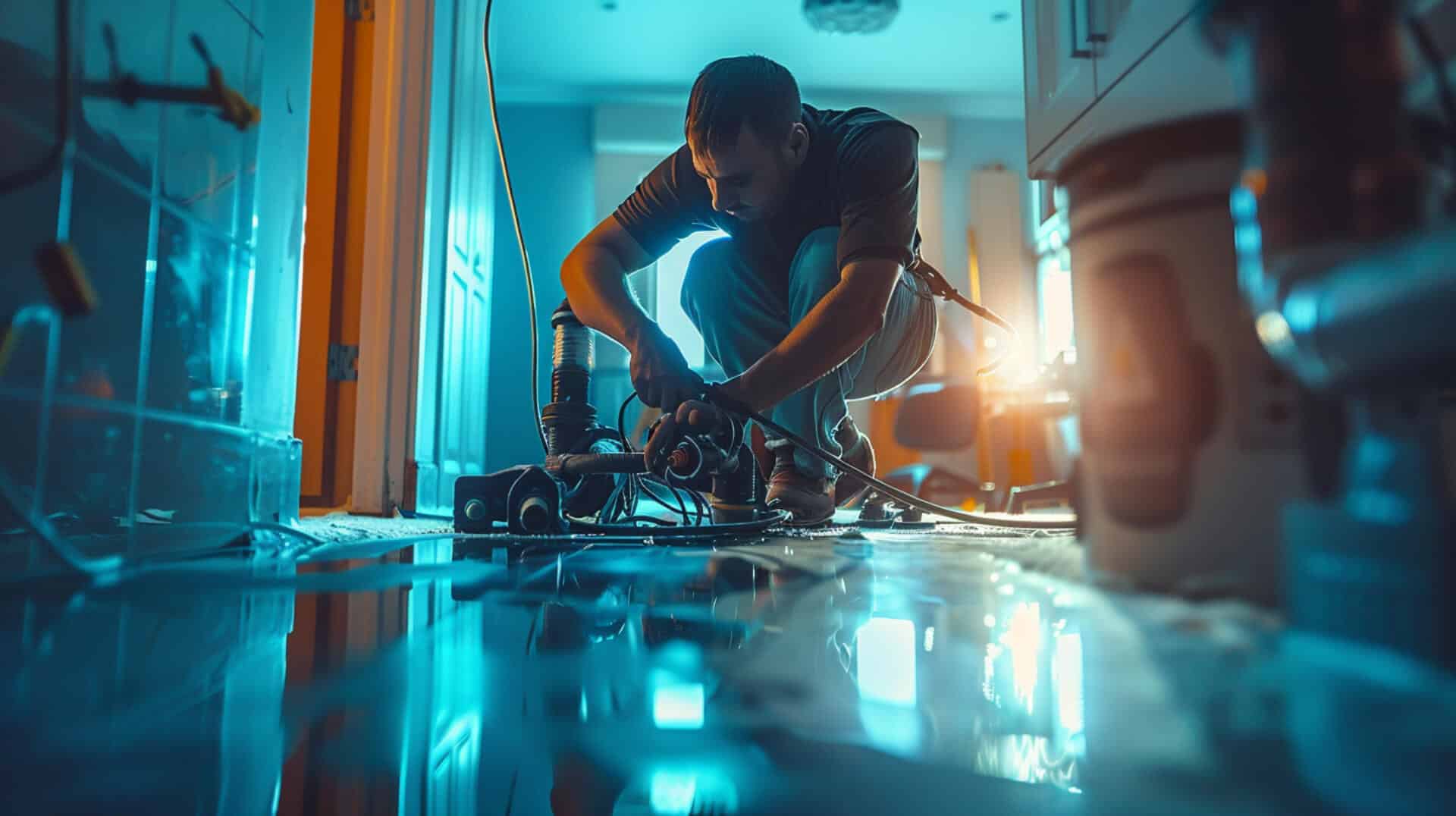
Understanding the drainage installation process is essential for property owners, business owners, and facility managers. It involves careful planning, selection of appropriate materials, and adherence to local regulations to ensure a functional and durable system.
Benefits of Professional Drainage Services
Professional drainage services offer expertise in designing and installing systems that effectively manage water flow, protecting properties from water damage. These services ensure that installations are compliant with current standards and are equipped to handle the specific drainage needs of each property.
Future Trends in Drainage Installation
The drainage industry is evolving, with trends pointing towards the resurgence of environmentally friendly materials like clayware and the increasing use of sustainable urban drainage systems (SuDS). These trends reflect a growing emphasis on eco-consciousness in property development.
Contribution to Property Value and Environmental Health
Proper drainage is a critical component of property infrastructure, contributing to the overall value and appeal of the property. It also plays a significant role in maintaining environmental health by preventing soil erosion and localised flooding, making it a vital aspect of responsible property management.
